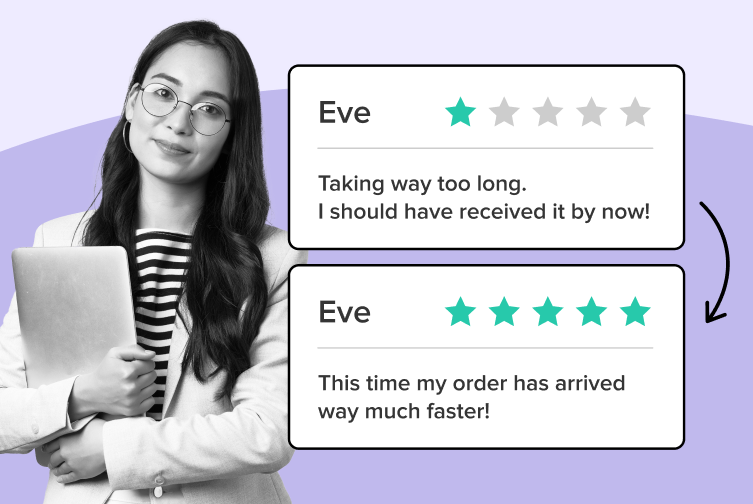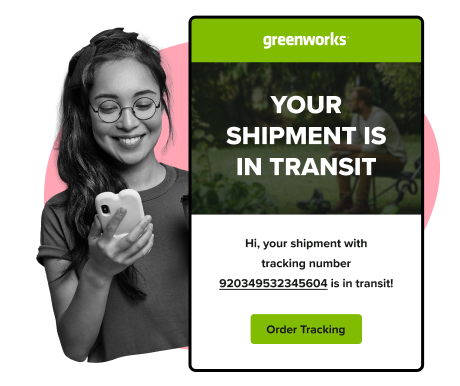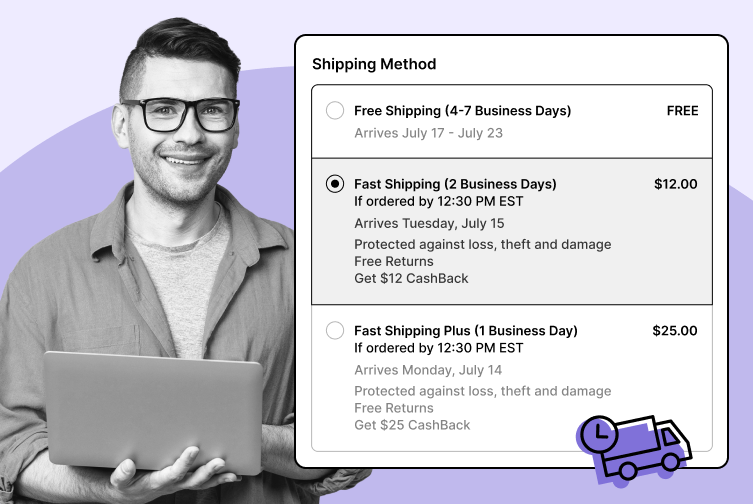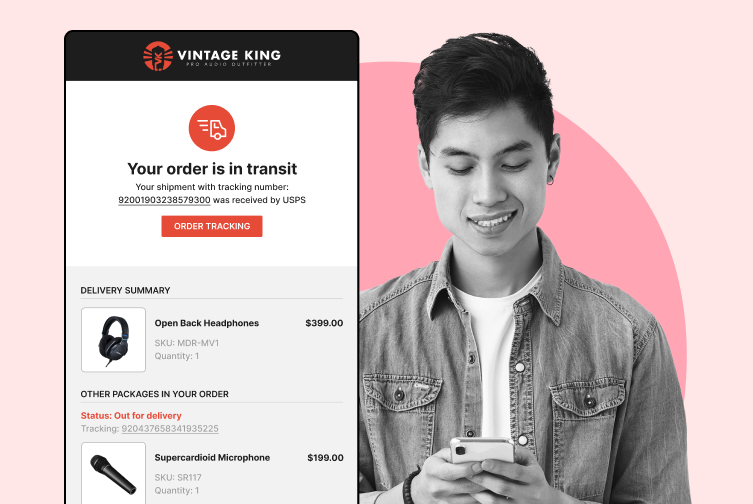
The Cost of Poor Shipping: Lost Sales, Bad Reviews, and Churn
Discover how poor shipping practices can impact your profits. Learn effective strategies to enhance your logistics and protect your bottom line. Read more!
Shipping, Tracking & Notifications
Boost customer experience and reduce support tickets
Realtime order and shipment tracking
Proactive order and shipping notifications
AI-Enhanced Discounted Labels
Predictive pre-purchase estimated delivery dates
Self-Serivce branded order tracking
Effortless experience delivered
Identify and Resolve Order Issues
Realtime order and shipment tracking
Make returns profitable and delight customers
Flexibility to define any return destinations & conditions
Simplify returns for your customers and team
Incentivize exchanges over returns
Returns management made easy for your team
Returns management made easy for your team
Easy claims and smart upsells
Understand why your customers are returning
In-Store & Curbside Pickup
Unify the online and the in-store experience
Hassle-free pickup experience for customers
In-Store dashboard to keep operations streamlined
In-Store and Online orders unified
Drive foot-traffic to your stores
Shipping, Tracking & Notifications
Boost customer experience and reduce support tickets
Realtime order and shipment tracking
Proactive order and shipping notifications
AI-Enhanced Discounted Labels
Predictive pre-purchase estimated delivery dates
Self-Serivce branded order tracking
Effortless experience delivered
Identify and Resolve Order Issues
Realtime order and shipment tracking
Make returns profitable and delight customers
Flexibility to define any return destinations & conditions
Simplify returns for your customers and team
Incentivize exchanges over returns
Returns management made easy for your team
Returns management made easy for your team
Understand why your customers are returning
In-Store & Curbside Pickup
Unify the online and the in-store experience
Hassle-free pickup experience for customers
In-Store Dashboard to keep operations streamlined
In-Store and Online orders unified
Drive foot-traffic to your stores
Boost customer experience and reduce support tickets
Realtime order and shipment tracking
Proactive order and shipping notifications
AI-Enhanced Discounted Labels
Predictive pre-purchase estimated delivery dates
Self-Serivce branded order tracking
Effortless experience delivered
Make returns profitable and delight customers
Flexibility to define any return destinations & conditions
Simplify returns for your customers and team
Incentivize exchanges over returns
Returns management made easy for your team
Equip your team for precise return checks.
Easy claims and smart upsells
Understand why your customers are returning
Unify the online and the in-store experience
Hassle-free pickup experience for customers
In-Store Dashboard to keep operations streamlined
In-Store and Online orders unified
Drive foot-traffic to your stores
Find the answer to all your questions
Take a step by step trip through our functionality to see how we can improve your ecommerce processes.
Explore the most comon questions about WeSupply
Calculate the ROI that WeSupply can bring you
Read actionable articles on how to optimize your post-purchase experience and decrease support tickets
Get inspired by stories of how our customers implemented an effortless post-purchase experience
Wondering if WeSupply is a good fit for you? Read through our use cases to see how we can help you increase conversion & improve CX!
A Deep Dive into Top Companies' Order Tracking & Returns Strategy
Find the answer to all your questions
Explore the most comon questions about WeSupply
Calculate the ROI that WeSupply can bring you
Request a no strings attached review of your current shopping experience and missed conversion opportunities
Take a step by step trip through our functionality to see how we can improve your ecommerce processes.
Read actionable articles on how to optimize your post-purchase experience and decrease support tickets
Get inspired by stories of how our customers implemented an effortless post-purchase experience
A Deep Dive into Top Companies' Order Tracking & Returns Strategy
Wondering if WeSupply is a good fit for you? Read through our use cases to see how we can help you increase conversion & improve CX!

Ecommerce shipping has undergone rapid transformation over the last decade, but 2025 marks a new frontier. With a confluence of rising consumer expectations, rapid technological advancements, and increased pressure from global supply chain disruptions, shipping is now a strategic differentiator for ecommerce brands. It’s no longer just about getting packages from point A to point B shipping has become a core component of the customer experience and a major driver of brand loyalty, operational efficiency, and profitability. To stay competitive, ecommerce businesses must understand and act on the evolving logistics trends shaping the market.
In this article, we’ll explore how to stay ahead of the top ecommerce shipping trends for 2025. We’ll highlight the key trends shaping the future of global supply chains and explain why understanding these shifts is crucial for building resilience and maintaining a competitive edge. From leveraging AI to tackling sustainability, from adapting to global supply chain volatility to offering hybrid fulfillment options, we’ll cover the actionable strategies that will keep your business thriving in a dynamic logistics environment.
Sustainability is no longer a nice-to-have; it’s a must-have. In 2025, over 53% of consumers expect retailers to implement eco-friendly practices. Not only are shoppers becoming more environmentally conscious, but they’re also willing to pay a premium for brands that align with their values. According to recent studies, 82% of consumers would spend more for sustainable packaging, and 63% are less likely to purchase if a product is shipped in wasteful materials.
Businesses that wish to remain competitive must embrace eco-friendly shipping practices. This includes using recyclable, biodegradable, or compostable packaging materials. Companies like Returnity are pioneering reusable mailers that can be used dozens of times, significantly reducing waste and environmental impact.
Offering carbon-neutral shipping is another vital step. Brands can partner with carriers that provide carbon offset programs or invest in their own green logistics initiatives, such as electric delivery vehicles or solar-powered warehouses. But it’s not just about implementation it’s also about communication. Clearly showcasing these efforts on product pages, checkout screens, and post-purchase emails builds trust and strengthens brand loyalty.
2025 is the year of smart logistics. Artificial Intelligence (AI), Machine Learning (ML), Augmented Reality (AR), and Blockchain are reshaping the way ecommerce businesses manage fulfillment.
AI plays a critical role in demand forecasting. By analyzing past purchase behavior, real-time website traffic, and even external factors like weather patterns, AI systems can predict what inventory will be needed, where, and when. This leads to smarter inventory placement, fewer stockouts, and faster fulfillment. AI also helps optimize delivery routes, adjusting in real time for traffic, weather, and road closures, thereby reducing delivery times and fuel consumption. Additionally, AI and analytics platforms enable businesses to monitor and respond to dynamic shipping pricing, helping manage costs in real time.
Augmented Reality is helping reduce returns by allowing customers to visualize products in real-world settings. Virtual try-ons for apparel, eyewear, and furniture, for instance, empower shoppers to make more confident purchases, reducing the likelihood of returns.
Blockchain technology is gaining traction for its ability to secure the supply chain. With an immutable ledger of transactions, blockchain enhances transparency, traceability, and fraud prevention, especially in international shipping.
Lastly, warehouse automation is accelerating order processing. Robotic arms, automated sorting systems, and self-driving forklifts are streamlining fulfillment operations and reducing reliance on human labor, which is increasingly scarce and expensive.
In a world of infinite choices, personalization is a key competitive edge. Studies show that 72% of consumers are more loyal to brands that offer personalized experiences. This extends far beyond marketing emails; it includes shipping preferences, delivery times, and post-purchase communications.
Give your customers the option to choose delivery time windows, select pickup points, or opt for contactless drop-offs. These small touches make a big difference in perceived convenience. AI-driven systems can even remember a customer’s past preferences and automatically suggest the most suitable options at checkout.
Real-time tracking is now expected. Ensure your shipping system provides up-to-date status updates via email, SMS, or mobile app. Proactive alerts about delays or changes help manage expectations and reduce inbound customer service inquiries.
The experience doesn’t end at delivery. Personalizing post-purchase messaging such as offering tips for product use, personalized cross-sell suggestions, or simple thank-you notes fosters connection and builds long-term loyalty.
Returns are a natural part of ecommerce, but how you handle them can make or break the customer relationship. According to research, four out of five consumers may abandon a purchase if the return process is complicated or unclear.
A frictionless return process is essential. Offer label-free or box-free returns, and consider allowing in-store drop-offs through partnerships with brick-and-mortar locations. The easier you make it for customers to return items, the more likely they are to shop with you again.
Use returns data strategically. Identify patterns in product issues, sizing inconsistencies, or shipping damages and use this feedback to improve listings, packaging, or product quality.
Forward-thinking companies are also turning returns into opportunities. Offering discounts for returned merchandise, selling refurbished items, or encouraging exchanges over refunds can help recover revenue while satisfying the customer.
Today’s shoppers expect fast and flexible delivery. Whether it’s same-day, next-day, or scheduled delivery, brands need robust fulfillment infrastructure to meet these demands.
Micro-fulfillment centers (MFCs) are becoming a popular solution. These small, urban warehouses reduce the distance between inventory and the end customer, enabling ultra-fast delivery. Urban warehousing, when paired with AI-powered demand planning, allows you to store the right items in the right locations at the right time.
Cross-docking is another strategy to streamline fulfillment. Goods are moved directly from inbound to outbound transport with minimal storage, reducing handling time and improving efficiency.
Container shipping strategies, such as choosing between less-than-container load (LCL) and full container load (FCL), play a crucial role in fulfillment speed and cost. Selecting the right ship and container type helps ecommerce businesses optimize delivery times and manage shipping costs, especially when handling fluctuating demand.
Partnering with third-party logistics (3PL), fourth-party (4PL), or even fifth-party (5PL) providers gives ecommerce businesses access to specialized infrastructure and technology without the need for capital investment. These providers offer scalability, geographic reach, and the latest innovations to keep your operations nimble and cost-effective.
Global ecommerce is growing, but it comes with challenges. From tariff changes to geopolitical disruptions, the international trade environment in 2025 remains complex. Recent changes in tariffs and ongoing trade disputes are significantly influencing global freight patterns and supply chain strategies. Supply chains must be resilient and adaptable.
To reduce risk, businesses should diversify their supplier base across multiple regions. Relying on a single country or transport route such as the Red Sea or Suez Canal exposes operations to disruption. This over-reliance increases risks, including regulatory risks and potential impacts on the transportation of Chinese goods due to policy changes or supply chain interruptions.
Explore alternative modes of transport, including air freight, intermodal shipping, and regional distribution hubs. These help minimize delays and provide backup options when traditional lanes become congested or compromised. Some shippers are now rerouting around the Cape of Good Hope to avoid congestion and disruptions in traditional maritime pathways.
Tariff mitigation strategies, such as tariff engineering or using bonded warehouses, can reduce costs and streamline customs processing. It’s crucial to stay informed on trade policy shifts and work with customs experts to navigate complex regulations.
The appetite for cross-border ecommerce continues to rise. According to recent reports, 55% of consumers would shop internationally more often if delivery options improved. Expanding globally can unlock huge growth, but it requires strategic execution.
Localization is key. Offer multi-language support, localized currency options, and culturally relevant messaging to build trust with international audiences. Comply with regional tax laws, data privacy regulations, and customs documentation requirements.
Work with international logistics providers that offer end-to-end shipping services, including customs clearance, duties prepayment, and last-mile delivery. Regional fulfillment centers in high-growth areas such as Southeast Asia, Latin America, and the Middle East can drastically reduce delivery times and costs. Cross-border ecommerce businesses must monitor shipping prices closely and be prepared for higher rates due to fluctuating demand, market disruptions, and global logistics challenges.
Air freight remains vital for fast international ecommerce delivery, but it’s also subject to price volatility and capacity constraints. In 2025, routes from China to the West Coast, in particular, are seeing significant demand spikes and price fluctuations. Air freight demand is being driven by ongoing eCommerce growth and policy changes, with potential for further increases depending on import thresholds and regional regulations.
Technology plays a crucial role in navigating this uncertainty. Use real-time freight monitoring platforms to track rates, capacity, and delivery times. Develop contingency plans, including alternative routes or transport modes, to manage sudden disruptions.
Air freight is especially crucial for high-value or time-sensitive goods. Ensure your strategy includes reliable partners and the ability to shift quickly when needed.
In an era marked by unpredictable demand spikes, tariff disruptions, and shifting trade policy, front-loading inventory has emerged as a key trend for ecommerce businesses seeking operational efficiency and cost savings. Front-loading involves importing goods earlier than usual often before the first quarter or ahead of anticipated tariff changes to avoid congestion, higher shipping rates, and potential supply chain bottlenecks.
This proactive approach allows businesses to mitigate risk by ensuring products are in place before peak seasons or major global events. It also provides a buffer against sudden increases in freight rates or delays caused by port congestion and blank sailings. Leveraging real-time data and predictive analytics, companies can identify optimal times to move inventory, taking advantage of lower rates and available capacity in the ocean freight market.
By front-loading, ecommerce brands can maintain a steady flow of goods, reduce the likelihood of stockouts, and better serve customers even during periods of global supply chain volatility. This strategy is especially valuable for those sourcing from regions like China or Southeast Asia, where ongoing disruptions and tariff uncertainties can impact lead times. Ultimately, front-loading is a smart way to stay competitive and resilient in a rapidly changing logistics environment.
Labor strikes and workforce shortages have become significant challenges for the logistics industry, with ripple effects across global supply chains. Strikes at major ports, particularly on the West Coast and in Europe, can lead to massive disruptions, causing delays, increased costs, and reduced available capacity for shipments. For ecommerce businesses, these disruptions can threaten delivery timelines and customer satisfaction.
To mitigate risk, companies are diversifying their transport modes and routes, shifting shipments to less-affected ports or using air cargo and intermodal solutions when necessary. Building contingency plans including alternative suppliers, flexible fulfillment centers, and partnerships with multiple logistics providers ensures greater agility when workforce disruptions occur.
Technology also plays a crucial role. Real-time data platforms enable businesses to monitor labor developments and adjust operations proactively. Investing in warehouse automation and robotics can help reduce reliance on human labor, improving operational efficiency and resilience. By staying informed and prepared, ecommerce brands can navigate workforce disruptions and keep their global logistics operations running smoothly.
With mobile commerce expected to make up 62% of all ecommerce sales by 2027, mobile optimization is no longer optional. Consumers want to manage every part of their shopping experience from their phones including shipping.
Ensure your mobile site or app supports easy address entry, shipping method selection, and package tracking. Integrate SMS updates and push notifications to keep customers informed.
Mobile-friendly customer service tools like live chat or AI-powered bots make it easier for shoppers to resolve issues on the go. The more seamless the mobile experience, the more likely consumers are to complete their purchase and return for more.
Shipping agility requires insight. By using predictive analytics and real-time data, businesses can proactively manage inventory, optimize carrier selection, and avoid delays. Platforms like ShipStation and ShipBob offer dashboards and tools that make data actionable.
Collaboration is another success factor. Build strong relationships with logistics providers, software platforms, and retail partners to extend your capabilities. Sharing infrastructure, insights, and resources can help scale quickly and meet spikes in demand.
Freight market intelligence is also critical. Stay informed about rate changes, service outages, and global logistics trends to make informed decisions. Track the global supply and capacity of ships, especially cargo ships, to anticipate future challenges in ocean freight and respond to shifts in shipping capacity.
Industry experts agree that the future of ecommerce shipping will be defined by adaptability, innovation, and a keen focus on emerging trends. As global supply chains become more complex, companies must embrace technological advancements such as AI-driven demand forecasting, blockchain for enhanced transparency, and automation to streamline operations. These tools not only drive cost savings but also enable businesses to respond swiftly to market changes.
Geopolitical tensions and shifting trade policy will continue to shape the freight market, with ongoing disruptions in regions like the Red Sea and Suez Canal prompting companies to diversify their trading partners and shipping routes. Experts also highlight the growing importance of sustainability, urging businesses to invest in green logistics solutions to meet evolving customer expectations and regulatory requirements.
Looking ahead, the rise of new markets in Southeast Asia, Latin America, and the Middle East presents significant growth opportunities for ecommerce brands willing to localize and adapt. Staying ahead means continuously monitoring logistics trends, collaborating with industry leaders, and remaining agile in the face of uncertainty. By heeding the insights of industry experts, businesses can position themselves for long-term success in the ever-evolving world of global logistics.
Consumers are increasingly seeking flexible shopping experiences that bridge online and offline. In 2025, 54% plan to shop more in-store while still relying on ecommerce for convenience.
Hybrid models like Buy Online, Pick Up In Store (BOPIS), same-day local delivery, and in-store returns are essential. These options reduce fulfillment costs, improve inventory turnover, and delight customers with flexibility.
Partnering with physical retailers or opening pop-up stores helps build brand presence in key markets without large overhead costs. It’s a win-win: customers enjoy a tactile shopping experience, and brands get valuable real-world engagement.
Regulatory landscapes are shifting fast, especially in cross-border ecommerce. From the Digital Personal Data Protection (DPDP) Act to drone delivery regulations, businesses must stay informed to avoid compliance issues and penalties.
Invest in legal expertise, compliance software, and staff training to ensure you’re meeting all requirements. Keep an eye on trends like social commerce and live shopping, which require agile logistics to support flash sales and influencer-driven demand spikes.
The ability to pivot quickly whether in response to regulation, consumer behavior, or market opportunity will define the most successful ecommerce businesses in 2025 and beyond.
In 2025, ecommerce shipping is more than logistics, it’s a key brand experience. To stay competitive in a fast-moving market shaped by sustainability demands, tech-driven expectations, and global supply chain volatility, you need a platform that keeps pace with every trend. That’s where WeSupply comes in.
WeSupply empowers ecommerce brands to lead not just keep up with powerful tools that drive transparency, convenience, and operational efficiency. Whether you’re navigating shifting consumer expectations or scaling across borders, WeSupply provides the visibility and control to turn shipping into a strategic advantage.
Combat inconvenience with proactivity & self service
Book a quick call with our experts to see how WeSupply can help you make returns easy for your customers with a beautiful, self-service solution that makes their experience easier while also providing new ways to lower costs and earn back revenue.
Key WeSupply Features That Align with 2025 Shipping Trends:
Automated Post-Purchase Notifications via email and SMS to personalize customer communication.
Branded Tracking Pages that extend your brand identity beyond checkout and boost engagement.
Seamless Returns Experience: Streamline the return process with self-service returns, prepaid labels, and real-time updates—turning returns into retention opportunities.
Analytics Dashboard that tracks return reasons, delivery performance, and customer behavior for smarter decisions.
Seamless Integration with top ecommerce platforms, 3PLs, and OMS systems to centralize fulfillment.
Curbside & In-Store Pickup Support to enable hybrid fulfillment models like BOPIS and local delivery.
Estimated Delivery Dates (EDD) displayed at checkout to set clear expectations and reduce cart abandonment.
Spot Delayed Shipments Instantly: Get notified of delivery slowdowns before your customers do—enabling proactive outreach and preserving customer trust.
Multi-Shipment & Split Order Support: No more confusion over split shipments. WeSupply keeps customers informed about which items are arriving when and from where.
Norton Shopping Guarantee Integration: Add an extra layer of customer confidence with protection against lost, stolen, or late packages.
Whether you’re adopting sustainable practices, preparing for global trade disruptions, or improving delivery personalization, WeSupply helps you ship smarter and serve better. In 2025, shipping is your brand’s frontline—make it count with WeSupply. Book a demo today!
Predictive pre-purchase estimated delivery dates
Book a quick call with our experts to see how WeSupply can help you set the appropriate expectations from the start and boost your conversion along the way.
Shipping is no longer a behind-the-scenes task, it’s a defining element of your brand experience and a critical driver of long-term growth. In 2025, winning ecommerce businesses are those that view shipping as a strategic asset, not just a cost center. That means prioritizing sustainability, personalization, speed, and global agility while delivering a frictionless post-purchase journey.
WeSupply helps brands transform shipping into a competitive edge. With real-time shipment tracking, branded tracking pages, and proactive delivery updates via email or SMS, you can deliver transparency and peace of mind. Estimated delivery dates shown at checkout set clear expectations, while automated post-purchase messaging builds trust and engagement. WeSupply also supports hybrid fulfillment options like BOPIS and curbside pickup, helping brands stay agile with evolving consumer preferences.
Its flexible returns portal makes exchanges easy, encourages repeat purchases, and reduces service costs. Meanwhile, advanced analytics help uncover delivery issues, optimize fulfillment, and reduce return rates.
By integrating seamlessly with your ecommerce platforms, 3PLs, and OMS tools, WeSupply ensures every touchpoint—from order to delivery to return—supports your brand promise. The future of ecommerce shipping is smarter, faster, and more customer-centric. With WeSupply, you’re ready to lead it.
1. What are the top ecommerce shipping trends in 2025?
Key 2025 shipping trends include sustainability, AI-powered logistics, mobile-first tracking, global fulfillment flexibility, and hybrid retail models like BOPIS. Brands must embrace tech, personalization, and transparency to stay competitive.
2. How does AI improve ecommerce shipping?
AI enhances demand forecasting, optimizes delivery routes, automates warehouses, and adjusts to real-time data. This boosts fulfillment speed, reduces costs, and minimizes delivery delays.
3. Why is sustainable shipping important in 2025?
Over half of consumers now expect eco-friendly practices. Sustainable shipping reduces waste, meets customer values, and can increase conversion and loyalty.
4. How does WeSupply improve post-purchase communication?
WeSupply automates branded notifications via email and SMS, provides real-time tracking, and keeps customers informed—even during delays.
5. Can WeSupply help with hybrid fulfillment like BOPIS?
Yes. WeSupply supports curbside pickup, in-store returns, and BOPIS, enabling flexible, convenient fulfillment that matches evolving customer expectations.
6. How does WeSupply reduce customer service inquiries?
With proactive delivery alerts, branded tracking pages, and a self-service returns portal, WeSupply keeps customers informed and reduces support volume.
7. Does WeSupply have an Official Shopify App?
Yes. WeSupply has an Official Shopify App. You can download it and start integrating with your Shopify Store.
8. Does WeSupply have an official Magento extension?
Yes, WeSupply has an official extension for Magento. The WeSupply x Magento integration allows for automating order tracking experiences, reducing customer inquiries, automating shipping email and SMS notifications, and providing a fully branded order tracking experience
9. Does WeSupply have an official BigCommerce App?
Yes, WeSupply has an official BigCommerce App. You can integrate WeSupply with your BigCommerce store to improve your post-purchase customer experience.

Learn How To Create Successful Post Purchase Email Campaigns
Build an effective post-purchase email flow that helps you increase customer satisfaction and drive revenue growth!

Discover how poor shipping practices can impact your profits. Learn effective strategies to enhance your logistics and protect your bottom line. Read more!

Discover effective shipping optimization strategies to lower return rates and costs. Enhance your logistics today!

Explore how shipping affects customer satisfaction and loyalty. Understand the key factors that influence their experience. Read the article to learn more.

Learn how dynamic shipping rates at checkout can enhance pricing strategies and improve customer satisfaction. Discover practical tips in our article.

Effective strategies for communicating shipping delays to keep customers informed and satisfied. Enhance your customer service approach!

Discover effective strategies to manage split shipments, reduce delays, and enhance customer satisfaction. Practical solutions!

Discover how enhanced estimated delivery dates can boost your e-commerce sales. Learn practical strategies to improve customer satisfaction today!
Master unified tracking for split or multi shipment orders with our comprehensive guide. Streamline your process and improve efficiency—read more now!

Learn effective strategies for handling shipment exceptions and improving customer communication. Read the article for practical tips and insights.